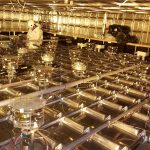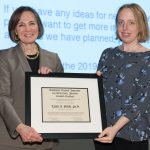From the Proceedings of the National Academy of Sciences, July 9, 2019: The international Deep Underground Neutrino Experiment, hosted by Fermilab, will start running in 2026, studying an intense beam of neutrinos that starts at Fermilab and that will be measured in underground caverns in Lead, South Dakota. Fermilab scientists Deborah Harris and Sam Zeller talk about the mysteries of neutrinos and how DUNE will address them in this in depth article.
Deep Underground Neutrino Experiment
From Kelo, July 19, 2019: Fermilab’s Patrick Weber and others talk about the international, Fermilab-hosted Deep Underground Neutrino Experiment and its Long-Baseline Neutrino Facility in this 8-minute video. Sanford Underground Research Facility is home to the DUNE far detector, and the world-leading research taking place at there is giving scientists from a variety of disciplines a wealth of information about the universe, the geology of the region and life underground.
From Kelo, July 10, 2019: Fermilab’s Bonnie Fleming talks about neutrinos, the international, Fermilab-hosted DUNE and and LBNF in this 9-minute video on the research taking place one mile underground in Lead, South Dakota, at the Sanford Underground Research Facility.
From Rapid City Journal, July 12, 2019: Fermilab Director Nigel Lockyer was the guest for a free public speaker series held one day prior to Neutrino Day, a full day of neutrino-themed public activities in Lead. Lockyer spoke about is known as the Deep Underground Neutrino Experiment (DUNE), housed in the Long Baseline Neutrino Facility (LBNF), which will have its South Dakota component at the Sanford Underground Research Facility in the former Homestake mine. It’s a billion-dollar international collaboration, and it’s described as the largest particle physics project ever built in the United States.
The Universities Research Association recognizes Fermilab scientist Laura Fields for her contributions to the field of accelerator-based neutrino physics. She co-leads the MINERvA experiment, which is making measurements necessary for tuning models of neutrino interactions used in ongoing and future neutrino experiments, and helped design a new focusing system for Fermilab’s LBNF neutrino beam.
From Exascale Computing Project, May 28, 2019: Fermilab scientist Andreas Kronfeld is featured in this piece on the Excascale Computing Project, quantum chromodynamics and lattice QCD. Kronfeld, the principal investigator of ECP’s LatticeQCD project, explains how exascale computing will be essential to extending the work of precision calculations in particle physics to nuclear physics. The calculations are central for interpreting all experiments in particle physics and nuclear physics.
June 5, 2019: DUNE recientemente integró a un grupo de investigadores de la Universidad EIA como unos de sus colaboradores. Buena noticia para la ciencia básica local.
From AIP’s FYI, May 27, 2019: The American Institute of Physics touts progress on the P5 plan with a photo of the ProtoDUNE detector and info on the international Deep Underground Neutrino Experiment, hosted by Fermilab.
From Korea JoongAng Daily, May 24, 2019: Chung-Ang University President Kim Chang-so discusses CAU’s collaboration with Fermilab on the Deep Underground Neutrino Experiment.


